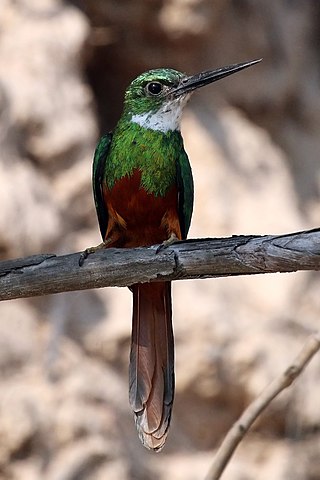
The jacamars are a family, Galbulidae, of near passerine birds from tropical South and Central America, extending up to Mexico. The family contains five genera and 18 species. The family is closely related to the puffbirds, another Neotropical family, and the two families are often separated into their own order, Galbuliformes, separate from the Piciformes. They are principally birds of low-altitude woodlands and forests, and particularly of forest edge and canopy.
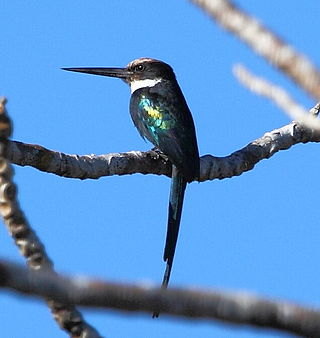
The paradise jacamar is a species of bird in the family Galbulidae. It is found in Bolivia, Brazil, Ecuador, French Guiana, Guyana, Peru, Suriname, and Venezuela.

The white-throated jacamar is a species of bird in the family Galbulidae. It is found in Bolivia, Brazil and Peru.

The brown jacamar is a species of bird in the family Galbulidae. It is found in Bolivia, Brazil, Colombia, Ecuador, French Guiana, Guyana, Peru, Suriname, and Venezuela.

The dusky-backed jacamar is a species of bird in the family Galbulidae. It is found in Colombia and Panama.

The white-eared jacamar is a species of bird in the family Galbulidae. It is found in Brazil, Colombia, Ecuador and Peru.

The Purus jacamar is a species of bird in the family Galbulidae. It is found in Bolivia, Brazil, and Peru.
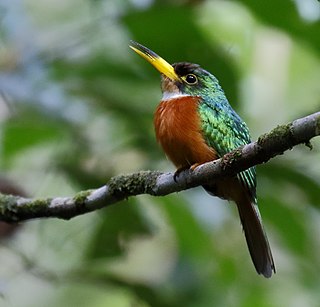
The yellow-billed jacamar is a species of bird in the family Galbulidae. It is found in Brazil, Colombia, Ecuador, French Guiana, Guyana, Peru, Suriname, and Venezuela.

Galbula is the type and largest genus of the jacamar family (Galbulidae) of piciform birds, and its suborder Galbulae. Sometimes, the Piciformes are split in two, with the Galbulae upranked to full order Galbuliformes.
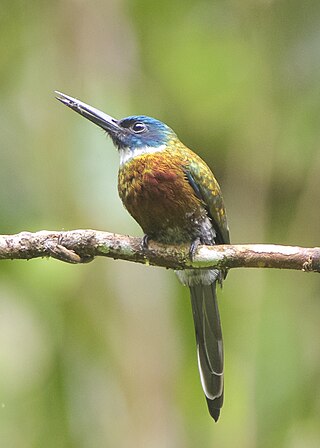
The purplish jacamar is a species of bird in the family Galbulidae. It is found in Brazil, Colombia, Ecuador, and Peru.

The bluish-fronted jacamar is a species of bird in the family Galbulidae. It is found in Bolivia, Brazil, and Peru.
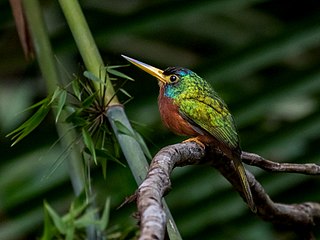
The blue-necked jacamar or blue-cheeked jacamar is a species of bird in the family Galbulidae. It is found in Brazil, Bolivia, and Peru.

The green-tailed jacamar is a species of bird in the family Galbulidae. It is native to Brazil, Colombia, French Guiana, Guyana, Suriname, and Venezuela.
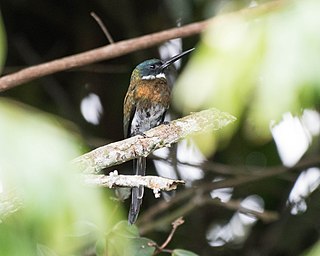
The bronzy jacamar is a species of bird in the family Galbulidae. It occurs in Bolivia, Brazil, Colombia, French Guiana, Guyana, Suriname, and Venezuela.

The coppery-chested jacamar is a species of bird in the family Galbulidae. It is found in Colombia, Ecuador and Peru.
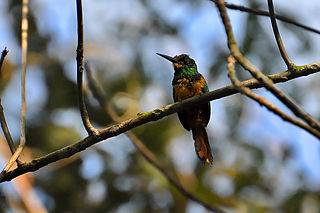
The white-chinned jacamar is a species of bird in the family Galbulidae. It is found in Brazil, Colombia, Ecuador, and Peru.

The great jacamar is a species of bird in the family Galbulidae. It is placed in the monotypic genus Jacamerops. It is found in Bolivia, Brazil, Colombia, Costa Rica, Ecuador, French Guiana, Guyana, Panama, Peru, Suriname, and Venezuela, where its natural habitat is subtropical and tropical moist lowland forests.

Tinaminae, the forest tinamous, is one of two subfamilies of the family Tinamidae, the other being Nothurinae. Tinaminae has more species than the other subfamily, containing 29 species in three genera:

Galbuli is one of the two suborders of the order Piciformes. It includes two families, Bucconidae (puffbirds) and Galbulidae (jacamars), both restricted to the Neotropics.





















